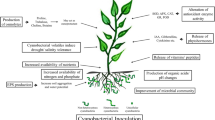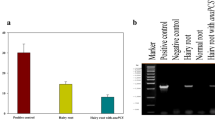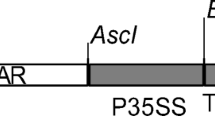Abstract
Cyanate and its derivatives are considered as environmental hazardous materials. Cyanate is released to the environment through many chemical industries and mining wastewater. Cyanase enzyme converts cyanate into CO2 and NH3 in a bicarbonate-dependent reaction. At low cyanate concentrations, the endogenous plant cyanases play a vital role in cyanate detoxification. However, such cyanate biodegradation system is probably insufficient due to the excess cyanate concentrations at contaminated sites. In this study, we have transferred the activity of the cyanobacterial cyanase into Arabidopsis thaliana plants in order to enhance plant resistance against cyanate toxicity. The enzyme was shown to be active in planta. Transgenic plants exposed to cyanate, either applied by foliar spray or supplemented in growth medium, showed less reduction in pigment contents, antioxidant enzymes, carbohydrate contents, and reduced levels of plant growth retardation. Plant growth assays under cyanate stress showed enhanced growth and biomass accumulation in cyanase overexpressors compared to control plants. Results of this study provide evidence for developing novel eco-friendly phytoremediation systems for cyanate detoxification.






Similar content being viewed by others
References
Aichi M, Nishida I, Omata T (1998) Molecular cloning and characterization of a cDNA encoding cyanase from Arabidopsis thaliana. Plant Cell Physiol 39:S135–S135
Akcil A, Mudder T (2003) Microbial destruction of cyanide wastes in gold mining: process review. Biotechnol Lett 25:445–450
Anderson PM (1980) Purification and properties of the inducible enzyme cyanase. Biochemistry 19:2882–2888
Anderson PM, Little RM (1986) Kinetic properties of cyanase. Biochemistry 25:1621–1626
Anderson PM, Sung Y-C, Fuchs JA (1990) The cyanase operon and cyanate metabolism. FEMS Microbiol Rev 7:247–252
Askari H, Edqvist J, Hajheidari M, Kafi M, Salekdeh GH (2006) Effects of salinity levels on proteome of Suaeda aegyptiaca leaves. Proteomics 6:2542–2554
Blank CE, Hinman NW (2016) Cyanobacterial and algal growth on chitin as a source of nitrogen; ecological, evolutionary, and biotechnological implications. Algal Res 15:152–163
Bradford MM (1976) A rapid and sensitive method for the quantitation of microgram quantities of protein utilizing the principle of protein-dye binding. Anal Biochem 72:248–254
Bushey JT, Ebbs SD, Dzombak DA (2006) Development of a plant uptake model for cyanide. International Journal of Phytoremediation 8:25–43
Butryn A, Stoehr G, Linke-Winnebeck C, Hopfner K-P (2015) Serendipitous crystallization and structure determination of cyanase (CynS) from Serratia proteamaculans. Acta Crystallographica Section F: Structural Biology Communications 71:471–476. doi:10.1107/S2053230X15004902
Chomczynski P, Mackey K (1995) Substitution of chloroform by bromo-chloropropane in the single-step method of RNA isolation. Anal Biochem 225:163–164
Clough SJ, Bent AF (1998) Floral dip: a simplified method for Agrobacteriumâ-mediated transformation of Arabidopsis thaliana. Plant J 16:735–743
Dirnhuber P, Schutz F (1948) The isomeric transformation of urea into ammonium cyanate in aqueous solutions. Biochem J 42:628
Dubois M, Gilles KA, Hamilton JK, Rebers P, Smith F (1956) Colorimetric method for determination of sugars and related substances. Anal Chem 28:350–356
Ebbs S (2004) Biological degradation of cyanide compounds. Curr Opin Biotechnol 15:231–236
Elleuche S, Poggeler S (2008) A cyanase is transcriptionally regulated by arginine and involved in cyanate decomposition in Sordaria macrospora. Fungal Genet Biol 45:1458–1469
Espie GS, Jalali F, Tong T, Zacal NJ, So AK-C (2007) Involvement of the cynABDS operon and the CO2-concentrating mechanism in the light-dependent transport and metabolism of cyanate by cyanobacteria. J Bacteriol 189:1013–1024
Garcia I, Castellano JM, Vioque B, Solano R, Gotor C, Romero LC (2010) Mitochondrial β-cyanoalanine synthase is essential for root hair formation in Arabidopsis thaliana. Plant Cell 22:3268–3279
Garcia-Fernandez JM, Diez J (2004) Adaptive mechanisms of nitrogen and carbon assimilatory pathways in the marine cyanobacteria Prochlorococcus. Res Microbiol 155:795–802
Grossmann K (1996) A role for cyanide, derived from ethylene biosynthesis, in the development of stress symptoms. Physiol Plant 97:772–775
Guilloton M, Karst F (1987) Isolation and characterization of Escherichia coli mutants lacking inducible cyanase. Microbiology 133:645–653
Gyorgyey J, Dl V, Jimenez-Zurdo JI, Charon C, Troussard L, Kondorosi A, Kondorosi E (2000) Analysis of Medicago truncatula nodule expressed sequence tags. Mol Plant-Microbe Interact 13:62–71
Hamel J (2011) A review of acute cyanide poisoning with a treatment update. Crit Care Nurse 31:72–82
Harano Y, Suzuki I, Maeda S-I, Kaneko T, Tabata S, Omata T (1997) Identification and nitrogen regulation of the cyanase gene from the cyanobacteria Synechocystis sp. strain PCC 6803 and Synechococcus sp. strain PCC 7942. J Bacteriol 179:5744–5750
Johnson W, Anderson P (1987) Bicarbonate is a recycling substrate for cyanase. J Biol Chem 262:9021–9025
Kamennaya NA, Post AF (2010) Characterization of cyanate metabolism in marine Synechococcus and Prochlorococcus spp. Appl Environ Microbiol 77:291–301. doi:10.1128/AEM.01272-10
Kamennaya NA, Chernihovsky M, Post AF (2008) The cyanate utilization capacity of marine unicellular Cyanobacteria. Limnol Oceanogr 53:2485
Kebeish R et al (2007) Chloroplastic photorespiratory bypass increases photosynthesis and biomass production in Arabidopsis thaliana. Nat Biotechnol 25:593–599
Kebeish R, Aboelmy M, El-Naggar A, El-Ayouty Y, Peterhansel C (2015) Simultaneous overexpression of cyanidase and formate dehydrogenase in Arabidopsis thaliana chloroplasts enhanced cyanide metabolism and cyanide tolerance. Environ Exp Bot 110:19–26. doi:10.1016/j.envexpbot.2014.09.004
Kebeish R, El-Sayed A, Fahmy H, Abdel-Ghany A (2016) Molecular cloning, biochemical characterization, and antitumor properties of a novel L-asparaginase from Synechococcus elongatus PCC6803. Biochem Mosc 81:1173–1181. doi:10.1134/S000629791610014X
Koncz C, Schell J (1986) The promoter of TL-DNA gene 5 controls the tissue-specific expression of chimaeric genes carried by a novel type of Agrobacterium binary vector. Mol Gen Genet MGG 204:383–396
Koshiishi I, Mamura Y, Imanari T (1997) Cyanate causes depletion of ascorbate in organisms. Biochimica et Biophysica Acta (BBA)-General Subjects 1336:566–574
Kraus LM, Kraus AP (2001) Carbamoylation of amino acids and proteins in uremia. Kidney Int 59:S102–S107
Kumar R, Saha S, Dhaka S, Kurade MB, Kang CU, Baek SH, Jeon B-H (2016) Remediation of cyanide-contaminated environments through microbes and plants: a review of current knowledge and future perspectives Geosystem Engineering:1–13
Kunz DA, Nagappan O (1989) Cyanase-mediated utilization of cyanate in Pseudomonas fluorescens NCIB 11764. Appl Environ Microbiol 55:256–258
Luque-Almagro VM et al (2008) Characterization of the Pseudomonas pseudoalcaligenes CECT5344 cyanase, an enzyme that is not essential for cyanide assimilation. Appl Environ Microbiol 74:6280–6288
Malhotra S, Pandit M, Kapoor J, Tyagi D (2005) Photo-oxidation of cyanide in aqueous solution by the UV/H2O2 process. J Chem Technol Biotechnol 80:13–19
Mc Mahon Smith J, Arteca RN (2000) Molecular control of ethylene production by cyanide in Arabidopsis thaliana. Physiol Plant 109:180–187
Mekuto L, Ntwampe S, Akcil A (2016) An integrated biological approach for treatment of cyanidation wastewater Science of The Total Environment
Miller AG, Espie GS (1994) Photosynthetic metabolism of cyanate by the cyanobacterium Synechococcus UTEX 625. Arch Microbiol 162:151–157
Niessen M, Thiruveedhi K, Rosenkranz R, Kebeish R, Hirsch H-J, Kreuzaler F, Peterhãnsel C (2007) Mitochondrial glycolate oxidation contributes to photorespiration in higher plants. J Exp Bot 58:2709–2715
Nowakowska M, Sterzel M, Szczubiałka K (2006) Photosensitized oxidation of cyanide in aqueous solutions of photoactive modified hydroxyethylcellulose. J Polym Environ 14:59–64
Nybom N (1955) The pigment characteristics of chlorophyll mutations in barley. Hereditas 41:483–498
O’Leary B, Preston GM, Sweetlove LJ (2014) Increased β-cyanoalanine nitrilase activity improves cyanide tolerance and assimilation in Arabidopsis. Mol Plant 7:231–243
Palatinszky M et al (2015) Cyanate as an energy source for nitrifiers. Nature 524:105–108
Patil Y, Paknikar K (2000) Development of a process for biodetoxification of metal cyanides from waste waters. Process Biochem 35:1139–1151
Peterhansel C, Horst I, Niessen M, Blume C, Kebeish R, Kürkcüoglu S, Kreuzaler F (2010) Photorespiration. Arabidopsis Book 8:e0123
Qian D, Jiang L, Lu L, Wei C, Li Y (2011) Biochemical and structural properties of cyanases from Arabidopsis thaliana and Oryza sativa. PLoS One 6:e18300
Rader WS, Solujic L, Milosavljevic EB, Hendrix JL, Nelson JH (1995) Photocatalytic detoxification of cyanide and metal cyano-species from precious-metal mill effluents. Environ Pollut 90:331–334
Rasco-Gaunt S, Riley A, Lazzeri P, Barcelo P (1999) A facile method for screening for phosphinothricin (PPT)-resistant transgenic wheats. Mol Breed 5:255–262
Reichel C et al (1996) Enhanced green fluorescence by the expression of an Aequorea victoria green fluorescent protein mutant in mono-and dicotyledonous plant cells. Proc Natl Acad Sci 93:5888–5893
Sancho J, Bellen F (2005) Developments of an alternative technology to remove cyanide from mining wastewater. In: I9th International Mine Water Congress, pp 413–417
Sancho J, Bellon F (2005) Developments of an alternative technology to remove cyanide from mining wastewater. In: I9th International Mine Water Congress, pp 413–417
Srivastava AC, Muni RRD (2010) Phytoremediation of cyanide. In: Plant Adaptation and Phytoremediation. Springer, pp 399–426
Sung Y-C, Parsell D, Anderson P, Fuchs J (1987) Identification, mapping, and cloning of the gene encoding cyanase in Escherichia coli K-12. J Bacteriol 169:2639–2642
Taebi A, Jeirani K, Mirlohi A, Zadeh Bafghi A (2008) Phytoremediation of cyanide-polluted soils by non-woody plants. JWSS-Isfahan University of Technology 11:515–523
Taussig A (1960) The synthesis of the induced enzyme, cyanase, in E. coli. Biochim Biophys Acta 44:510–519
Trapp S, Larsen M, Pirandello A, Danquah-Boakye J (2003) Feasibility of cyanide elimination using plants ejmp & ep. Eur J Miner Process Environ Prot 3:128–137
Voigt K, Sharma CM, Mitschke J, Lambrecht SJ, Voss B, Hess WR, Steglich C (2014) Comparative transcriptomics of two environmentally relevant cyanobacteria reveals unexpected transcriptome diversity. The ISME journal 8:2056–2068
Walsh MA, Otwinowski Z, Perrakis A, Anderson PM, Joachimiak A (2000) Structure of cyanase reveals that a novel dimeric and decameric arrangement of subunits is required for formation of the enzyme active site. Structure 8:505–514
Xu P, Zou J, Meng Q, Zou J, Jiang W, Liu D (2008) Effects of Cd 2+ on seedling growth of garlic (Allium sativum L.) and selected physiological and biochemical characters. Bioresour Technol 99:6372–6378
Yu X-Z, Zhou P-H, Yang Y-M (2006) The potential for phytoremediation of iron cyanide complex by willows. Ecotoxicology 15:461–467
Yu X-Z, Lu P-C, Yu Z (2012) On the role of β-cyanoalanine synthase (CAS) in metabolism of free cyanide and ferri-cyanide by rice seedlings. Ecotoxicology 21:548–556
Acknowledgments
This work was supported by the Deanship of Scientific Research, Taibah University, KSA (project no. 6925) and partially supported by the Egyptian Science and Technology Development Fund (STDF). We are thankful to Dr. Ahmed Saleh and Dr. Ahmed Khalil (Biology Department, Faculty of Science-Yanbu, Taibah University) for the valuable discussion and correction of the manuscript.
Author information
Authors and Affiliations
Corresponding author
Additional information
Responsible editor: Yi-ping Chen
Rights and permissions
About this article
Cite this article
Kebeish, R., Al-Zoubi, O. Expression of the cyanobacterial enzyme cyanase increases cyanate metabolism and cyanate tolerance in Arabidopsis . Environ Sci Pollut Res 24, 11825–11835 (2017). https://doi.org/10.1007/s11356-017-8866-z
Received:
Accepted:
Published:
Issue Date:
DOI: https://doi.org/10.1007/s11356-017-8866-z




